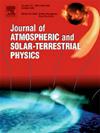Large area ionospheric D region height determination method based on lightning electromagnetic pulse
IF 1.8
4区 地球科学
Q3 GEOCHEMISTRY & GEOPHYSICS
Journal of Atmospheric and Solar-Terrestrial Physics
Pub Date : 2025-01-21
DOI:10.1016/j.jastp.2025.106446
引用次数: 0
Abstract
This study investigates the method of determining the height of the ionospheric D region over large areas using lightning electromagnetic pulse (LEMP) signals. Utilizing the LEMP waveforms and lightning location data from the Institute of Electrical Engineering, Chinese Academy of Sciences (IEECAS), and fully leveraging both cloud-to-ground (CG) lightning and narrow bipolar pulses (NB), a deep-learning-based method for LEMP detection and correction of ionospheric D region height calculation errors has been proposed. This approach enables the computation of the D region height in real time. For the first time, this research has obtained real-time data on the D region height for China and its surrounding areas. Also, variations in the D region height during solar flares have been observed. The results indicate that the method presented in this paper provides novel data support for the investigation of the ionosphere and illustrates the potential utility of lightning in probing solar activity.
求助全文
约1分钟内获得全文
求助全文
来源期刊

Journal of Atmospheric and Solar-Terrestrial Physics
地学-地球化学与地球物理
CiteScore
4.10
自引率
5.30%
发文量
95
审稿时长
6 months
期刊介绍:
The Journal of Atmospheric and Solar-Terrestrial Physics (JASTP) is an international journal concerned with the inter-disciplinary science of the Earth''s atmospheric and space environment, especially the highly varied and highly variable physical phenomena that occur in this natural laboratory and the processes that couple them.
The journal covers the physical processes operating in the troposphere, stratosphere, mesosphere, thermosphere, ionosphere, magnetosphere, the Sun, interplanetary medium, and heliosphere. Phenomena occurring in other "spheres", solar influences on climate, and supporting laboratory measurements are also considered. The journal deals especially with the coupling between the different regions.
Solar flares, coronal mass ejections, and other energetic events on the Sun create interesting and important perturbations in the near-Earth space environment. The physics of such "space weather" is central to the Journal of Atmospheric and Solar-Terrestrial Physics and the journal welcomes papers that lead in the direction of a predictive understanding of the coupled system. Regarding the upper atmosphere, the subjects of aeronomy, geomagnetism and geoelectricity, auroral phenomena, radio wave propagation, and plasma instabilities, are examples within the broad field of solar-terrestrial physics which emphasise the energy exchange between the solar wind, the magnetospheric and ionospheric plasmas, and the neutral gas. In the lower atmosphere, topics covered range from mesoscale to global scale dynamics, to atmospheric electricity, lightning and its effects, and to anthropogenic changes.
 求助内容:
求助内容: 应助结果提醒方式:
应助结果提醒方式:


